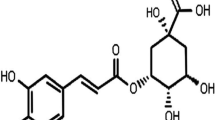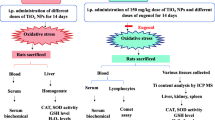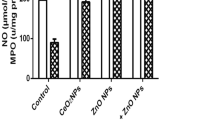Abstract
Lead, a highly toxic pollutant, causes numerous health problems and affects nearly all biological systems thus arousing interest in using antioxidants to reduce its toxic effects. Therefore, the undertaken study estimated the influence of cerium oxide nanoparticles (CeO2-NPs) on the lead acetate–induced genotoxicity and inflammation in the kidney and heart tissues of mice. Twenty male mice were randomly divided into negative control and lead acetate and/or CeO2-NPs administrated groups. Comet and diphenylamine assays were conducted to assess the DNA damage and the expression of apoptosis-related genes and inflammatory cytokines were also measured in addition to the estimation of reactive oxygen species (ROS) level. Co-administration of CeO2-NPs significantly reduced the DNA damage and ROS generation caused by lead acetate in the kidney and heart tissues. The co-administration of CeO2-NPs also ameliorated the lead acetate–induced dysregulation in the expression levels of p53, K-ras, interleukin-6, and cyclooxygenase-2 in the kidney and heart. Conclusion: the co-administration of CeO2-NPs suppresses the genotoxicity, inflammation, and ROS generation resulting from lead acetate administration and restoring the genomic DNA integrity; thus, administration of CeO2-NPs is recommended to minimize the lead acetate–induced hazards.







Similar content being viewed by others
Data availability
The datasets used and/or analyzed during the current study are available from the corresponding author on reasonable request.
References
Gania MU, Siddiquia MSI, Rashid MHO, Islam K, Moonmoon S, Ahmed S, Mostofa M (2016) Effect of lead acetate alone and in combination with whole milk (Star ship®) on body growth and liver functions in an experimentally induced lead toxicity in rat. Asian J Med Biol Res 2(2):183–189
Mitra P, Sharma S, Purohit P, Sharma P (2017) Clinical and molecular aspects of lead toxicity: an update. Crit Rev Clin Lab Sci 54:506–528
Khan MSH, Mostofa M, Jahan MS, Sayed MA, Hossain MA (2008) Effect of garlic and vitamin B-complex in lead acetate induced toxicities in mice. Bangladesh J Veter Med 6(2):203–210
Abdel Moneim AE, Dkhil MA, Al-Quraishy S (2011) The protective effect of flaxseed oil on lead acetate-induced renal toxicity in rats. J Hazard Mater 194:250–255
Flora G, Gupta D, Tiwari A (2012) Toxicity of lead: a review with recent updates. Interdiscip Toxicol 5:47–58
AL-Megrin WA, Soliman D, Kassab RB, Metwally DM, Abdel Moneim AE, El-Khadragy MF (2020) Coenzyme Q10 activates the antioxidant machinery and inhibits the inflammatory and apoptotic cascades against lead acetate-induced renal injury in rats. Front Physiol 11
Baş H, Kalender Y (2016) Nephrotoxic effects of lead nitrate exposure in diabetic and nondiabetic rats: involvement of oxidative stress and the protective role of sodium selenite. Environ Toxicol 31(10):1229–1240
Wu X, Cobbina SJ, Mao G, Xu H, Zhang Z, Yang L (2016) A review of toxicity and mechanisms of individual and mixtures of heavy metals in the environment. Environ Sci Pollut Res Int 23(9):8244–8259
Al-Megrin WA et al (2019) Antagonistic efficacy of luteolin against lead acetate exposure-associated with hepatotoxicity is mediated via antioxidant, anti-inflammatory, and anti-apoptotic activities antioxidants (Basel) 9
Moreira R, Moreira J (2004) Os efeitos do chumbo sobre o organism humano e seu significado para a saude Pan Am. J Public Health 15:119–129
Kiran Kumar B, Prabhakara Rao Y, Noble T, Weddington K, McDowell VP, Rajanna S, Bettaiya R (2009). Lead-induced alteration of apoptotic proteins in different regions of adult rat brain. Toxicol Lett. 10;184(1):56-60
Xu J, Lian LJ, Wu C, Wang XF, Fu WY, Xu LH (2008) Lead induces oxidative stress, DNA damage and alteration of p53, Bax and Bcl-2 expressions in mice. Food Chem Toxicol 46:1488–1494. https://doi.org/10.1016/j.fct.2007.12.016
Shah SS, Denham LV, Elison JR, Bhattacharjee PS, Clement C, Huq T, Hill JM (2010) Drug delivery to the posterior segment of the eye for pharmacologic therapy. Expert Rev Ophthalmol 5(1):75–93
Varela-Fernández R, Díaz-Tomé V, Luaces-Rodríguez A, Conde-Penedo A, García-Otero X, Luzardo-Álvarez A, Fernández-Ferreiro A, Otero-Espinar FJ (2020) Drug delivery to the posterior segment of the eye: biopharmaceutic and pharmacokinetic considerations. Pharmaceutics 12(3):269
Corma A, Atienzar P, Garcı´AH, Chane-Ching JY (2004). Hierarchically mesostructured doped cerium oxide with potential for solar-cell use. Nat Mater. 3:394–397
Zhai YQ, Zhang SY, Pang H (2007) Preparation, characterization and photo catalytic activity of cerium oxide nanocrystalline using ammonium bicarbonate as precipitan. Mater Lett 61:1863–1866
Tarnuzzer RW, Colon J, Patil S, Seal S (2005) Vacancy engineered ceria nanostructures for protection from radiation induced cellular damage. Nano Lett 5:2573–2577
Das M, Patil S, Bhargava N, Kang JF, Riedel LM, Seal S, Hickman JJ (2007) Auto-catalytic ceria nanoparticles offer neuroprotection to adult rat spinal cord neurons. Biomaterials 28:1918–1925
Korsvik C, Patil S, Seal S, Self WT (2007) Superoxide dismutase mimetic properties exhibited by vacancy engineered ceria nanoparticles. Chem Commun 14:1056–1058
Colon J, Herrera L, Smith J, Patil S, Komanski C, Kupelian P, Seal S, Jenkins DW, Baker CH (2009) Protection from radiation-induced pneumonitis using cerium oxide nanoparticles. Nanomed Nanotechnol Biol Med 5:225–231
Hirst SM, Karakoti A, Singh S, Self W, Tyler R, Seal S, Reilly CM (2011) Bio-distribution and in vivo antioxidant effects of cerium oxide nanoparticles in mice
Estevez AY, Pritchard S, Harper K, Aston JW, Lynch A, Lucky JJ, Ludington JS, Chatani P, Mosenthal WP, Leiter JC, Andreescu S, Erlichman JS (2011) Neuroprotective mechanisms of cerium oxide nanoparticles in a mouse hippocampal brain slice model of ischemia. Free Radic Biol Med 51:1155–1163
Pirmohamed T, Dowding JM, Singh S, Wasserman B, Heckert E, Karakoti AS, King JE, Seal S, Self WT (2010) Nanoceria exhibit redox state-dependent catalase mimetic activity. Chem Commun (Camb) 46:2736–2738
Hosseini A, Sharifi AM, Abdollahi M, Najafi R, Baeeri M, Rayegan S, Cheshmehnour J, Hassani S, Bayrami Z, Safa M (2015) Cerium and yttrium oxide nanoparticles against lead-induced oxidative stress and apoptosis in rat hippocampus. Biol Trace Elem Res 164(1):80–89
Amer M, Farahat F, Abdelkhalik A, Hassan H (2020) Protective effects of cerium oxide nanoparticles on oxaliplatin induced neurotoxicity in adult male albino rats. Zagazig J For Med 18(1):52–67
Khorrami MB, Sadeghnia HR, Pasdar A, Ghayour-Mobarhan M, Riahi-Zanjani B, Hashemzadeh A, Zare M, Darroudi M (2019) Antioxidant and toxicity studies of biosynthesized cerium oxide nanoparticles in rats. Int J Nanomed 14: 2915–2926
Hajinezhad M, Shahri SH, Rahdar A, Zamanian H (2020) Effects of cerium oxide nanoparticles on biochemical parameters and histopathological changes in lead-intoxicated rats. Dis Diag 9(4):134–139
Sepanjnia A, Ghasemi H, Mohseni R, Ranjbar A, Shabani F, Salimi F, Kheiripour N (2020) Effect of cerium oxide nanoparticles on oxidative stress biomarkers in rats’ kidney, lung, and serum. Iran Biomed J 24(4):251–256
Sharma S, Singh B (2014) Effects of acute and chronic lead exposure on kidney lipid peroxidation and antioxidant enzyme activities in BALB-C mice (Mus Musculus). Int J Sci Res 3(9):1564–1567
Burlinson B, Tice RR, Speit G, Agurell E, Brendler-Schwaab SY, Collins AR, Escobar P, Honma M, Kumaravel TS, Nakajima M, Sasaki YF, Thybaud V, Uno Y, Vasquez M, Hartmann A (2007) Fourth International Workgroup on Genotoxicity testing: results of the in vivo comet assay workgroup. Mutat Res 627:31–35
Recio L, Hobbs C, Caspary W, Witt KL (2010) Dose-response assessment of four genotoxic chemicals in a combined mouse and rat micronucleus (MN) and comet assay protocol. J Toxicol Sci. 35(2):149–62
Gercel-Taylor C (2005) Diphenylamine assay of DNA fragmentation for chemosensitivity testing. Methods Mol Med 111:79–82
Gutierrez MI, Bhatia K, Siwarski D, Wolff L, Magrath IT, Mushinski JF, Huppi K (1992) Infrequent p53 mutation in mouse tumors with deregulated myc. Cancer Res 52, 1032-1035
Watanabe H, Shimokado K, Asahara T, Dohi K, Niwa O (1999) Analysis of the c-myc, K-ras and p53 genes in methylcholanthrene-induced mouse sarcomas. Jpn J Cancer Res 90:40–47
Singh UP, Singh NP, Singh B, Hofseth LJ, Price RL, Nagarkatti M, Nagarkatti PS (2010) Resveratrol (trans-3,5,4′-trihydroxystilbene) induces silent mating type information regulation-1 and down-regulates nuclear transcription factor-kappaB activation to abrogate dextran sulfate sodium-induced colitis. J Pharmacol Exp Ther 332(3):829–839
Oh Y-C, Jeong Y-H, Cho V-K, Gu M-J, Ma JY (2014) Inhibitory effects of palmultang on inflammatory mediator production related to suppression of NF-κB and MAPK pathways and induction of HO-1 expression in macrophages. Int J Mol Sci 2014(15):8443–8457
Siddiqui MA, Kashyap MP, Kumar V, Al-Khedhairy AA, Musarrat J et al (2010) Protective potential of trans-resveratrol against 4-hydroxynonenal induced damage in PC12 cells. Toxicol In Vitro 24:1592–1598
Abd El-Monem DD, Foaad MA (2012) The protective effect of melatonin against lead acetate toxicity. J Am Sci 8(3):478–485
Alghazal MA, Šutiaková I, Kovalkovičová N, Legáth J, Falis M, Pistl J, Sabo R, Beňová K, Sabová L, Váczi1 P (2008). Induction of micronuclei in rat bone marrow after chronic exposure to lead acetate trihydrate. Toxicol Indust Health 24: 587–593
Alcaraz-Contreras Y, Mendoza-Lozano RP, Martı´nez-Alcaraz ER, Martı´nez-Alfaro M, Gallegos-Corona MA, Ramı´rez-Morales MA, Va´zquez-Guevara MA (2016) Silymarin and dimercaptosuccinic acid ameliorate lead-induced nephrotoxicity and genotoxicity in rats. Hum Experiment Toxicol 35(4) 398–403
Kim HS, Lee HJ, Jung WY, Weon J, Young RS (2016) Comparative evaluation of genotoxic effects of lead and red color iron oxide in rat colon. Toxicol Environ Health Sci 8:309–314
Wang A, Pu K, Dong B et al (2013) Role of surface charge and oxidative stress in cytotoxicity and genotoxicity of graphene oxide towards human lung fibroblast cells. J Appl Toxicol 33:1156–1164
El-Yamanya A, Faten F. Mohamedb⁎, Taher A. Salaheldinc,d, Amany A. Tohamya, Walaa N Abd El-Mohsena, Adel S. Amine (2017). Graphene oxide nanosheets induced genotoxicity and pulmonary injury in mice Nabil. Experiment Toxicol Pathol 69: 383–392
Valko M, Morris H, Cronin MT (2005) Metals, toxicity and oxidative stress. Curr Med Chem 12(10):1161–1208
Sabath E, Robles-Osorio ML (2012) Renal health and the environment: heavy metal nephrotoxicity. Nefrologia 32:279–286
Flora SJS (2002) Nutritional components modify metal absorption, toxic response and chelation therapy. J Nutr Environ Med 12:53–67
Flora SJ, Flora G, Saxena G, Mishra M (2007) Arsenic and lead induced free radical generation and their reversibility following chelation. Cell Mol Biol 53:26–47
Tounekti O, Kenani A, Foray N, Orlowski S, Mir LM (2001) The ratio of single- to double-strand DNA breaks and their absolute values determine cell death pathway. Br J Cancer 84 1272e1279
Jackson SP, Bartek J (2009) The DNA-damage response in human biology and disease. Nature 461(7267):1071–1078
Chen M, Yin J, Liang Y, Yuan S, Wang F, Song M and Wang H (2016). Oxidative stress and immunotoxicity induced by graphene oxide in zebrafish. Aqua Toxicol 174(1879–1514 (Electronic)):54–60
Bartkova J, Rezaei N, Liontos M, Karakaidos P, Kletsas D, Issaeva N, Vassiliou LV, Kolettas E, Niforou K, Zoumpourlis VC (2006) Oncogene induced senescence is part of the tumorigenesis barrier imposed by DNA damage checkpoints. Nature 444(7119):633–637
Lupidi G, Bramucci M, Quassinti L, Fornari E, Avenali L, Khalife H, Gali-Muhtasib H (2011) Antiproliferative activities of Artemisia herba-alba ethanolic extract in human colon cancer cell line (HCT116). Alt Med Stud 1(1):55–59
Moding E J Min HD, Castle KD, Ali M, Woodlief L, Williams N, Ma Y, Kim Y, Lee C-L, Kirsch DG (2016) An extra copy of p53 suppresses development of spontaneous K-ras-driven but not radiation-induced cancer. J CIinsight 1–11
Mittal M, Siddiqui MR, Tran K, Reddy SP, Malik AB (2014) Reactive oxygen species in inflammation and tissue injury. Antioxid Redox Signal 20(7):1126–1167
Colon J, Hsieh N, Ferguson A, Kupelian P, Seal S, Jenkins DW, Baker CH (2010) Cerium oxide nanoparticles protect gastrointestinal epithelium from radiation-induced damage by reduction of reactive oxygen species and up regulation of superoxide dismutase 2. Nanomedicine 6:698–705
Chen S, Hou Y, Cheng G, Zhang C, Wang S, Zhang J (2013) Cerium oxide nanoparticles protect endothelial cells from apoptosis induced by oxidative stress. Biol Trace Elem Res 154:156–166
Abdelhamid AM, Mahmoud SS, Abdelrahman AE, Said NM, Toam M, Samy W, Amer MA (2020) Protective effect of cerium oxide nanoparticles on cisplatin and oxaliplatin primary toxicities in male albino rats. Naunyn Schmiedebergs Arch Pharmacol 393(12):2411–2425
Hamzeh M, Hosseinimehr SJ, Karimpour A, Mohammadi HR, Khalatbary AR, Talebpour Amiri F (2019) Cerium oxide nanoparticles protect cyclophosphamide-induced testicular toxicity in mice. Int J Prevent Med 10 5
Karakoti A, Singh S, Dowding JM, Seal S, Self WT (2010) Redox-active radical scavenging nanomaterials. Chem Soc Rev 39:4422–4432
Saleh H, Nassar AMK, Noreldin AE, Samak D, Elshony N, Wasef L, Elewa YHA, Hassan SMA, Saati AA, Hetta HF, Batiha GE, Umezawa M, Shaheen HM, El-Sayed YS (2020) Chemo-protective potential of cerium oxide nanoparticles against fipronil-induced oxidative stress, apoptosis, inflammation and reproductive dysfunction in male white albino rats. Molecules. 25(15):3479
Acknowledgements
Special thanks, gratitude, and appreciation for the assistance from the Department of Zoology, Faculty of Science, Cairo University.
Funding
The present work was partially funded by the Cairo University, Faculty of Science, Giza, Egypt.
Author information
Authors and Affiliations
Contributions
HRHM: designing the study, conducting the molecular experiments, writing the manuscript, and performing statistical analysis.
Corresponding author
Ethics declarations
Consent for Publication
Not applicable.
Consent for Participation
Not applicable.
Conflict of Interest
The author declares no competing interests.
Additional information
Publisher's Note
Springer Nature remains neutral with regard to jurisdictional claims in published maps and institutional affiliations.
Rights and permissions
About this article
Cite this article
Mohamed, H.R.H. Acute Oral Administration of Cerium Oxide Nanoparticles Suppresses Lead Acetate–Induced Genotoxicity, Inflammation, and ROS Generation in Mice Renal and Cardiac Tissues. Biol Trace Elem Res 200, 3284–3293 (2022). https://doi.org/10.1007/s12011-021-02914-9
Received:
Accepted:
Published:
Issue Date:
DOI: https://doi.org/10.1007/s12011-021-02914-9




